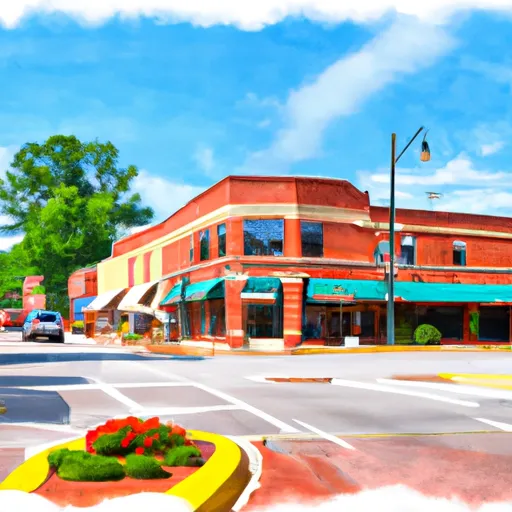-
 Snoflo Premium
Snoflo Premium
Get unlimited access to all our content
With no Ad interruptions! - Start Your Free Trial Login with existing account
Conyers
Eden Index
Climate
8.0
•
Recreation
4.5
•
Community
2.2
•
Safeguard
5.3/10

Conyers is a city located in Rockdale County, Georgia. The climate in Conyers is characterized by hot summers and mild winters, with an average temperature of 62°F. The city sits at the intersection of two rivers, the Yellow River and the South River, which provide important hydrological constituents. There are several outdoor recreation opportunities in Conyers, including the Arabia Mountain National Heritage Area, which offers hiking trails, rock climbing, and unique geological formations. The Georgia International Horse Park also offers horseback riding, concerts, and festivals. Additionally, visitors can enjoy fishing, boating, and swimming at the nearby Lake Varner. Overall, Conyers offers a range of outdoor activities for nature enthusiasts.
What is the Eden Index?
The Snoflo Eden Index serves as a comprehensive rating system for regions, evaluating their desirability through a holistic assessment of climate health, outdoor recreation opportunities, and natural disaster risk, acknowledging the profound impact of these factors on livability and well-being.
Climate Health Indicator (CHI): 8.0
Conyers receives approximately
1242mm of rain per year,
with humidity levels near 81%
and air temperatures averaging around
17°C.
Conyers has a plant hardyness factor of
8, meaning
plants and agriculture in this region tend to thrive here all year round.
By considering the ideal temperature range, reliable water supplies, clean air, and stable seasonal rain or snowpacks, the Climate Health Indicator (CHI) underscores the significance of a healthy climate as the foundation for quality living.
A healthy climate is paramount for ensuring a high quality of life and livability in a region, fostering both physical well-being and environmental harmony. This can be characterized by ideal temperatures, reliable access to water supplies, clean air, and consistent seasonal rain or snowpacks.
Weather Forecast
Streamflow Conditions
Altamaha
Area Rivers
Altamaha
Snowpack Depths
Altamaha
Reservoir Storage Capacity
Altamaha
Groundwater Levels
Recreational Opportunity Index (ROI): 4.5
The Recreational Opportunity Index (ROI) recognizes the value of outdoor recreational options, such as parks, hiking trails, camping sites, and fishing spots, while acknowledging that climate plays a pivotal role in ensuring the comfort and consistency of these experiences.
Access to outdoor recreational opportunities, encompassing activities such as parks, hiking, camping, and fishing, is crucial for overall well-being, and the climate plays a pivotal role in enabling and enhancing these experiences, ensuring that individuals can engage in nature-based activities comfortably and consistently.
Camping Areas
| Campground | Campsites | Reservations | Toilets | Showers | Elevation |
|---|---|---|---|---|---|
| James Shackleford County Park | None | 904 ft | |||
| Arrowhead County Park | None | 390 ft | |||
| High Falls State Park | None | 600 ft | |||
| Whitewater Creek County Park | 48 | 293 ft | |||
| Andersonville City Campground | 25 | 350 ft | |||
| Indian Springs State Park | None | 503 ft | |||
| Newton Factory Shoals Rec Area | None | 608 ft | |||
| Stone Mountain Park Campground | 430 | 1,558 ft | |||
| Parks at Chehaw | 50 | 201 ft | |||
| Georgia Veterans State Park | None | 273 ft |
Nearby Ski Areas
Catastrophe Safeguard Index (CSI):
The Catastrophe Safeguard Index (CSI) recognizes that natural disaster risk, encompassing floods, fires, hurricanes, and tornadoes, can drastically affect safety and the overall appeal of an area.
The level of natural disaster risk in a region significantly affects safety and the overall livability, with climate change amplifying these risks by potentially increasing the frequency and intensity of events like floods, fires, hurricanes, and tornadoes, thereby posing substantial challenges to community resilience and well-being.
Community Resilience Indicator (CRI): 2.2
The Community Resilience Indicator (CRI) recognizes that education, healthcare, and socioeconomics are crucial to the well-being of a region. The CRI acknowledges the profound impact of these elements on residents' overall quality of life. By evaluating educational resources, healthcare accessibility, and economic inclusivity, the index captures the essential aspects that contribute to a thriving community, fostering resident satisfaction, equity, and social cohesion.

